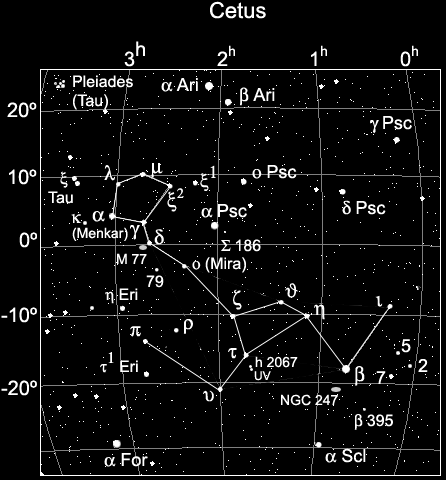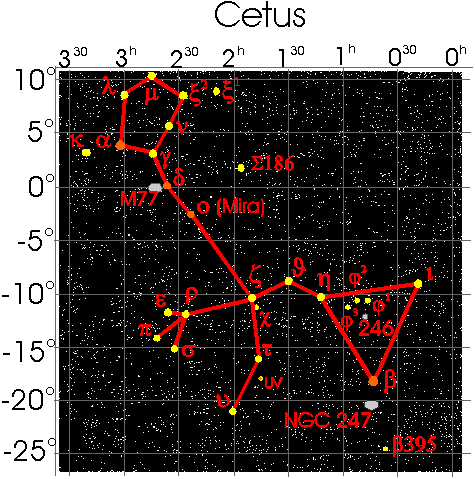
Cetus, The Whale, is an ancient constellation of late autumn, between Pisces and Taurus, although its brightest star, beta Ceti, is farther to the south. Alpha, while the principal star of the whale's head, isn't the constellation's brightest star. This is beta, farther to the south. In between these two is the spectacular Mira, the most famous of all variable stars.

Alpha Ceti is ‘Menkar’, the nose of the whale. Or perhaps the sea beast, as it was often depicted. The star, not quite as bright as beta --to the south-- is quickly found by examining the night sky with the naked eye. First locate Aldebaran then to the west to Hamal. Menkar is to the south, making a triangle. Alpha and gamma are in the same FOV. From alpha move up to lambda (in the same field if alpha is placed the southern edge of your glasses), west of lambda is mu, and then xi2 is seen west of mu. Finally southeast of xi2 we're back to gamma. From gamma starhop down the body of the whale.
Beta Ceti (Deneb Kaitos, The Tail of the Whale) is the brightest star in this constellation, with a visual magnitude of 2.0. Beta Ceti is found easily with the naked eye south of Alpheratz or southwest of Menkar. Beta Ceti has several 5th-mag neighbours. The bright spiral galaxy NGC 247 (which needs a medium-sized telescope) is two and a half degrees to the south-southeast of beta.
Delta Ceti is the neck of the whale, an unassuming 4.1 magnitude star with a Messier neighbour, M77. With gamma at the northern edge of your binocular view, delta Ceti is centred. M77 (NGC 1068) is a tiny face-on spiral which really needs at least a medium-sized telescope. M77 is considered one of the most distant of Messier's objects, at about 50 million light years away. This region is useful for starhopping to omicron Ceti (Mira), the most famous of all long-period variables. Locate 75 Ceti to the southwest of delta. Now place this star at the northeastern edge and you'll be in the region of Mira.
Omicron Ceti is Mira, the Admirable One, or simply ‘Wonderful’, the most notable of all variables. Mira changes its magnitude from a usual 9th-magnitude (barely seen with binoculars) to a very bright 3rd-magnitude every 331 days. The recently published data from Hipparcos gives Mira a visual magnitude of 2.0 and a distance of 418 light years, about half the distance it was formerly thought to have. As the period is very nearly eleven months, Mira's annual return to brilliance is a regular occurance eagerly awaited by many amateur astronomers. In 2000 this return should occur in late September. To find Mira, starhop from alpha, down to gamma and delta, thence to 75 Ceti. You can also get to Mira from alpha Piscium: drop down one and a half fields southeast of alpha Piscium.
